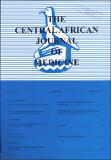| dc.contributor.author | M’kumbuzi, V.R.P. | |
| dc.contributor.author | Ntawukuriryayo, J.T. | |
| dc.contributor.author | Habimana, J.D. | |
| dc.contributor.author | Munyandamutsa, J. | |
| dc.contributor.author | Nzakizwanimana, E. | |
| dc.coverage.spatial | Rwanda | en |
| dc.date.accessioned | 2016-02-12T10:38:29Z | |
| dc.date.available | 2016-02-12T10:38:29Z | |
| dc.date.issued | 2012-01 | |
| dc.identifier.citation | M'kumbuzi, V.R.P. et al., (2012) Accuracy of straight leg raise and slump tests in detecting lumbar disc herniation: a pilot study, Central African Journal of Medicine, vol. 58, nos. 1/4, pp. 5-11. Harare: CAJM. | en |
| dc.identifier.issn | 0008-9176 | |
| dc.identifier.uri | https://opendocs.ids.ac.uk/opendocs/handle/20.500.12413/8965 | |
| dc.description | A research paper on low back pain (LBP) observed and studied in Kigali, Rwanda. | en |
| dc.description.abstract | Low back pain (LBP) is the most common musculoskeletal condition, with a lifetime prevalence of 84% in the general adult population. One often diagnosed cause id a herniated inter-vertebral disc exerting pressure on the nerve root. This is clinically
termed lumbar disc herniation (LDH). In LDH, physical examination findings, reported symptoms, and findings on the imaging technique do not always correlate. | en |
| dc.language.iso | en | en |
| dc.publisher | Faculty of Medicine, Central African Journal of Medicine (CAJM), University of Zimbabwe (UZ) | en |
| dc.rights.uri | http://creativecommons.org/licenses/by-nc-nd/3.0/ | en |
| dc.subject | Health | en |
| dc.title | Accuracy of straight leg raise and slump tests in detecting lumbar disc herniation: a pilot study | en |
| dc.type | Article | en |
| dc.rights.holder | University of Zimbabwe (UZ) | en |


